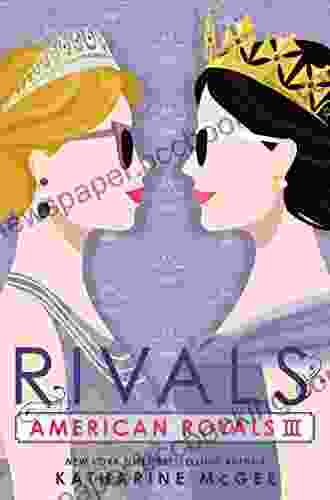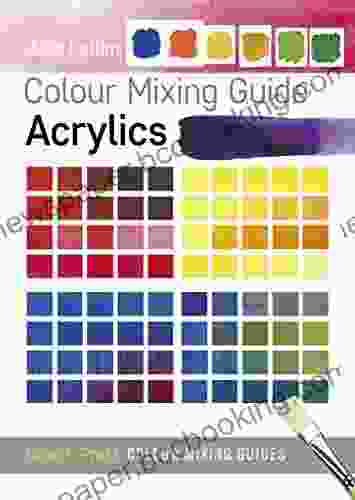Unlock the Secrets of Color Mixing with Acrylics: The Definitive Guide

As an artist working with acrylics, mastering the art of color mixing is essential for creating vibrant and captivating artworks. This comprehensive guide will empower you with the knowledge and techniques to effectively blend acrylics, enabling you to achieve the precise colors and effects you desire. Whether you're a beginner or an experienced painter, this guide will provide valuable insights and practical tips to elevate your artistic skills.
Understanding Color Theory
Color theory is a fundamental concept that underlies all color mixing. It involves understanding the relationships between different colors, how they interact when combined, and how they can be utilized to create various effects. In this section, we'll explore the basics of color theory and how it applies to acrylics.
4.3 out of 5
| Language | : | English |
| File size | : | 44829 KB |
| Screen Reader | : | Supported |
| Print length | : | 48 pages |
Color Wheel
The color wheel is a circular diagram that organizes all colors based on their relationships. It consists of three primary colors (red, yellow, and blue),three secondary colors (orange, green, and violet),and six tertiary colors (formed by mixing a primary and a secondary color). Understanding the color wheel will help you navigate the vast spectrum of colors and make informed mixing decisions.
Color Harmonies
By combining colors from different areas of the color wheel, you can create harmonious color schemes that enhance the overall visual impact of your artwork. Some common color harmonies include:
- Monochromatic: Using different values and intensities of a single color.
- Analogous: Using colors adjacent to each other on the color wheel.
- Complementary: Using colors opposite each other on the color wheel.
- Triadic: Using colors evenly spaced apart on the color wheel.
Materials and Techniques
In this section, we'll discuss the specific materials and techniques involved in color mixing with acrylics. From choosing the right brushes to understanding the effects of different mediums and additives, you'll gain practical knowledge to optimize your mixing process.
Selecting the Right Brushes
For effective color mixing, choosing the right brushes is crucial. Synthetic brushes, such as nylon or polyester, are commonly used for acrylics due to their durability and ability to hold and release paint well. Different brush shapes and sizes will allow you to achieve various mixing effects.
Acrylic Mediums and Additives
Acrylic mediums and additives can significantly enhance the versatility and performance of your acrylic paints. Glazing mediums, for example, increase transparency, while impasto mediums add body and texture. Additionally, additives such as retarders can extend the drying time, giving you more time to mix and blend.
Mixing Techniques
There are various techniques for mixing acrylics, each with its unique advantages. Some common methods include:
- Stirring: Using a brush or mixing knife to combine colors directly on the palette.
- Wet-on-wet: Applying one wet color onto another wet color on the canvas.
- Glazing: Applying thin layers of transparent or semi-transparent paint over one another.
- Drybrush: Using a brush with minimal paint to create a textured effect.
Creating Specific Colors
Now that you understand the basics of color mixing, let's delve into specific color combinations and how to achieve them with acrylics. This section will provide a detailed guide to mixing a wide range of hues, from basic colors to complex shades and tints.
Primary Colors
Red, yellow, and blue are the primary colors. They cannot be created by mixing other colors and form the foundation of all other colors.
Secondary Colors
Secondary colors are created by mixing two primary colors. Orange (red + yellow),green (yellow + blue),and violet (blue + red).
Tertiary Colors
Tertiary colors are created by mixing a primary and a secondary color. For example, mixing red and orange creates red-orange, while mixing blue and green creates blue-green.
Tints and Shades
Tints are created by adding white to a color, while shades are created by adding black to a color. By varying the amount of white or black added, you can create a wide range of values and intensities.
Common Mixing Mistakes
Even experienced artists can make mistakes when mixing acrylics. Here are some common pitfalls to avoid:
- Overmixing: Mixing colors too much can result in a muddy or dull appearance.
- Insufficient mixing: Not mixing colors thoroughly enough can lead to uneven or streaky results.
- Using dirty brushes: Mixing with dirty brushes can introduce unwanted colors into your mixtures.
- Mixing on absorbent surfaces: Avoid mixing on paper towels or other absorbent surfaces as they can absorb the moisture from the paint, affecting the mixing process.
- Neglecting to clean your palette: Regularly cleaning your palette will prevent color buildup and ensure accurate mixing.
Mastering acrylic color mixing is a journey that requires practice and experimentation. By understanding the principles of color theory, using the appropriate materials and techniques, and learning from common mistakes, you can develop a keen eye for color and create vibrant and harmonious artworks. This guide has equipped you with a solid foundation in acrylic color mixing, empowering you to unlock the full potential of this versatile medium.
4.3 out of 5
| Language | : | English |
| File size | : | 44829 KB |
| Screen Reader | : | Supported |
| Print length | : | 48 pages |
Do you want to contribute by writing guest posts on this blog?
Please contact us and send us a resume of previous articles that you have written.
 Book
Book Novel
Novel Page
Page Chapter
Chapter Text
Text Story
Story Genre
Genre Reader
Reader Library
Library Paperback
Paperback E-book
E-book Magazine
Magazine Newspaper
Newspaper Paragraph
Paragraph Sentence
Sentence Bookmark
Bookmark Shelf
Shelf Glossary
Glossary Bibliography
Bibliography Foreword
Foreword Preface
Preface Synopsis
Synopsis Annotation
Annotation Footnote
Footnote Manuscript
Manuscript Scroll
Scroll Codex
Codex Tome
Tome Bestseller
Bestseller Classics
Classics Library card
Library card Narrative
Narrative Biography
Biography Autobiography
Autobiography Memoir
Memoir Reference
Reference Encyclopedia
Encyclopedia K C Mills
K C Mills Julian Hosp
Julian Hosp Justin Hammond
Justin Hammond Siri Hustvedt
Siri Hustvedt Kat Socks
Kat Socks Julian Randall
Julian Randall Mateo Nicolas
Mateo Nicolas Kat Anderson
Kat Anderson Julian Laboy
Julian Laboy Katarzyna Peoples
Katarzyna Peoples Julia Adamo
Julia Adamo Melissa Higgins
Melissa Higgins Kim Dragoner
Kim Dragoner Karen A Moon
Karen A Moon Karen Myers
Karen Myers Louise Douglas
Louise Douglas Judy Greenspan
Judy Greenspan Julia Baird
Julia Baird Michelle Segar Phd
Michelle Segar Phd Justin Mccurry
Justin Mccurry
Light bulbAdvertise smarter! Our strategic ad space ensures maximum exposure. Reserve your spot today!

 Federico García LorcaStep Inside the Raiders' Den: An Unforgettable Journey with "Tales From The...
Federico García LorcaStep Inside the Raiders' Den: An Unforgettable Journey with "Tales From The... Jason ReedFollow ·12.3k
Jason ReedFollow ·12.3k Doug PriceFollow ·5.2k
Doug PriceFollow ·5.2k Ian PowellFollow ·9.5k
Ian PowellFollow ·9.5k Javier BellFollow ·19.7k
Javier BellFollow ·19.7k Clarence BrooksFollow ·9.5k
Clarence BrooksFollow ·9.5k Ruben CoxFollow ·8.1k
Ruben CoxFollow ·8.1k Ernest ClineFollow ·19.6k
Ernest ClineFollow ·19.6k David BaldacciFollow ·11k
David BaldacciFollow ·11k

 Drew Bell
Drew BellLife and Death in West Africa: A Groundbreaking Account...
A Journey Through...

 Stanley Bell
Stanley BellMaster the Art of Fly Fishing Line Management: A...
Are you an avid fly...

 Ernest Powell
Ernest PowellUnleash Your Entrepreneurial Spirit: A Comprehensive...
In the competitive...

 Derrick Hughes
Derrick HughesMaster Your Ride: The Ultimate Guide to Road Bike...
Are you ready to elevate your cycling...

 Camden Mitchell
Camden MitchellUnveiling the Enchanting World of American Royals III:...
Embark on a Captivating Royal Saga: American...

 Richard Simmons
Richard SimmonsUnveiling the Secrets of Fly Tying: A Comprehensive...
In the realm of...
4.3 out of 5
| Language | : | English |
| File size | : | 44829 KB |
| Screen Reader | : | Supported |
| Print length | : | 48 pages |










